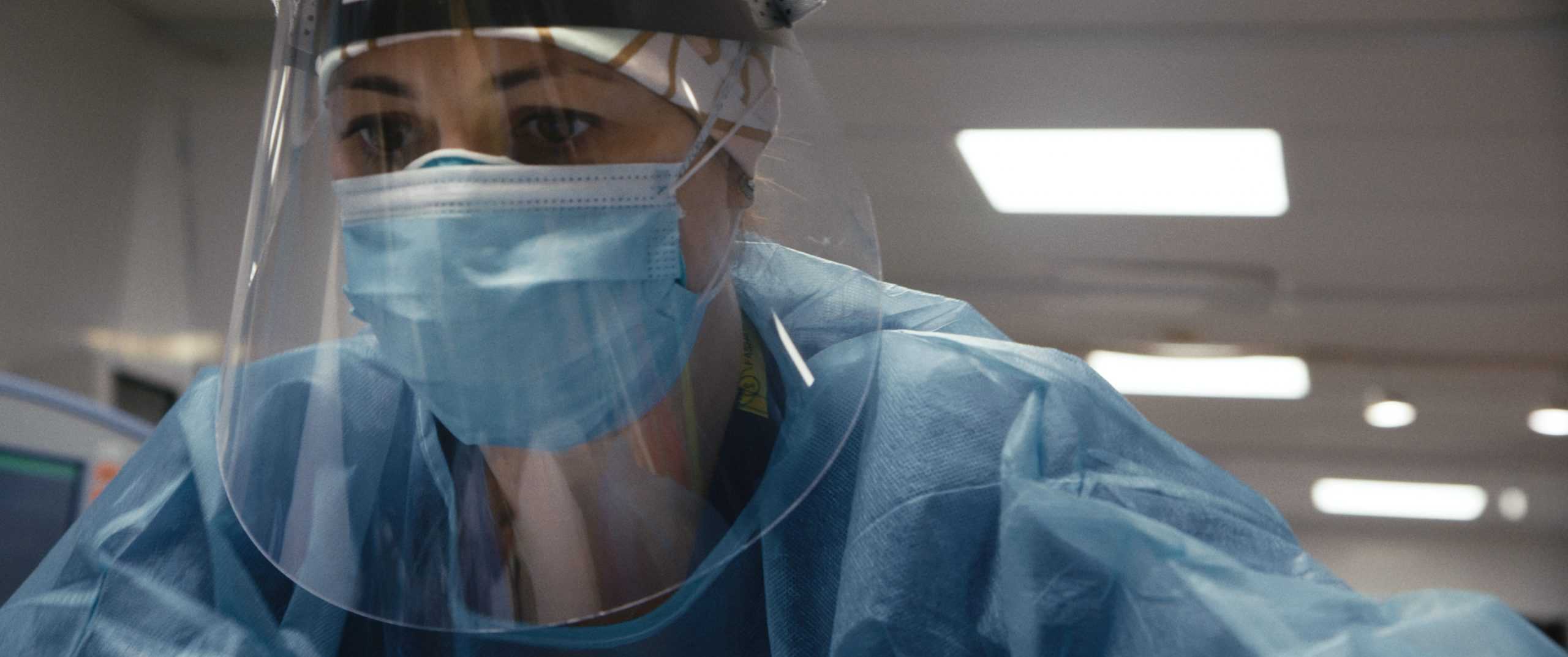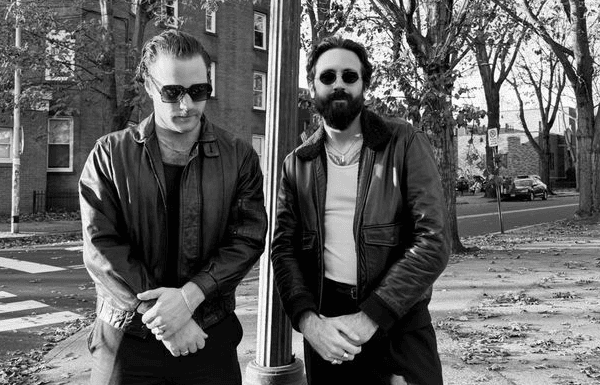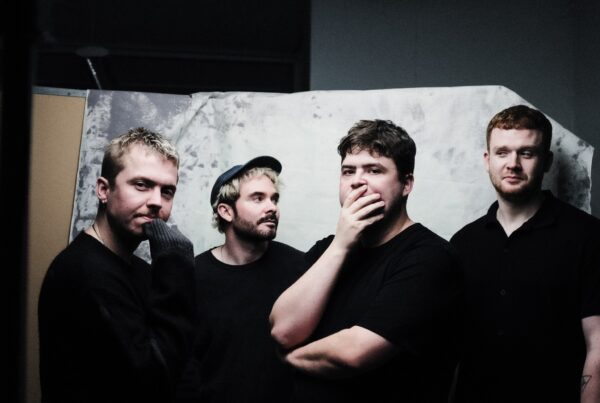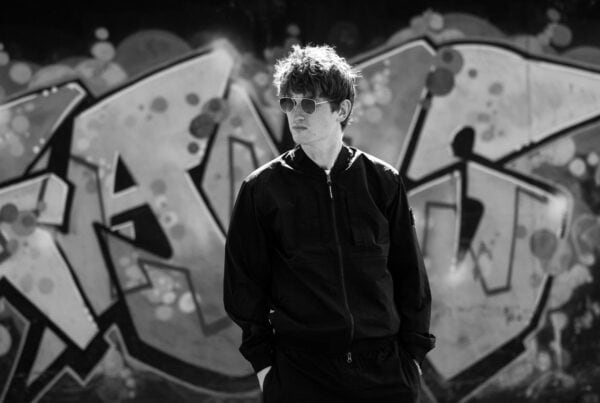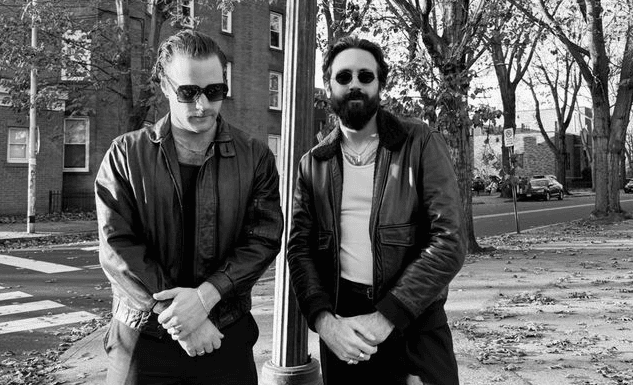Words: Callie Petch
Most people who could afford to probably did not wake up one morning in March of 2020 feeling compelled to enter ground zero for the United States of America’s then-nascent COVID-19 pandemic. Matthew Heineman, Oscar-nominated documentarian, is not most people. Having spent much of his acclaimed career bringing an empathetic and journalistic eye to such subjects as the fight against Mexico’s drug cartels and Syrian journalists’ efforts to escape the control of ISIS, Heineman is no stranger to putting his life at risk in an effort to educate and demystify terrifying situations for his audience. “I felt this enormous obligation to try and tell this story,” he tells me in a Zoom call on the eve of said story’s UK theatrical release. “At that point, everyone was inundated with headlines and stats and misinformation. We, as an American public, were so shielded from the realities of what was going on inside hospitals. I think that was a large reason why this pandemic was allowed to be so politicised, to further divide an already fractured society, because we weren’t seeing those images coming out of these hospitals.”
I’d argue it wasn’t just Americans being shielded from the realities of what was going on inside hospitals during the early onset stages of the pandemic. Anecdotally, my mother is a nurse at Scunthorpe General Hospital and, because of my Type 1 diabetes, I am considered someone who is at a high-risk of contracting COVID-19. I spent as much of those first six months as possible minimising my trips outside, social distancing, wearing a mask in my sparsely-populated neighbourhood, and subconsciously fearing for my mother’s life every single time she went into work. I knew that things were bad, particularly from the ever-rising nightly statistics of infections and deaths plastered all over the news, but, and particularly as the weeks rolled into months, I struggled to envision just how bad they were inside hospitals. I’d ask my mother every now and again about what it was like and how she was holding up, only to be greeted with some non-descript vague-ity and a quick change of subject. Perhaps we both knew that fully acknowledging the risk and chaos of the reality in her COVID-era day-to-day tempted a total paralytic mental shutdown in fear. So, our, and particularly my, subconscious would mystify it to some extent.
I imagine many others, particularly those in similarly privileged-bubbles that keep them out of harm’s way with no COVID cases in the family, operated the same way. Boiled the onset of COVID down to statistics eventually easy to tune out in order to keep functioning (in the non-malicious cases). Like Heineman says, that lack of access to the full horrifying extent of the pandemic on people who contracted it and the frontline workers charged with keeping us safe from it can lead to dangerous misinformation or, worse, apathy regarding the severity of proceedings. I distinctly remember, two months into the virus, being out walking the dog and overhearing neighbours on a nearby street discussing the pandemic and lockdowns with the phrase “I’m bored of COVID now,” as if it’s Freddy Krueger and everyone talking about it was what was giving the virus its power.
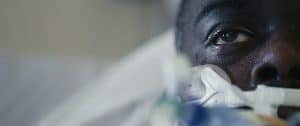
(credit: National Geographic Documentary Films / The First Wave)
Heineman’s The First Wave, documenting the first four months of the COVID-19 pandemic upon Long Island Jewish Medical Centre, demystifies that relentless chaos, confusion, and terror which was a daily occurrence when so little was known about the virus. Opening on unsparing footage of doctors and nurses intubating a COVID patient, successfully reviving him after a long period of flatlining, only for his condition to reverse without warning mid-transit to a different wing, this time fatally. It’s as stark a depiction of the lethality of the virus as has yet been put to film. The director of Cartel Land and City of Ghosts calls it “the hardest film [he’s] ever made.” “Physically, logistically, mentally, creatively… a full-on 24/7 experience” since the film’s events take place in his current backyard, New York City, and the nature of COVID suddenly made him aware of things he used to take for granted as a filmmaker. “Putting a loud mic on somebody, putting your camera on a countertop to take a rest, eating food, going to the bathroom. These are all potential ways to either spread or get the virus.” At the same time, perhaps because of that, the resulting work is “the film [he’s] most proud of.”
One of the more striking things about Heineman’s film is how it quietly ends up functioning as a corrective to inadvertently White-centric narratives about the virus. Researchers have shown that the COVID pandemic has disproportionately affected minorities across the globe, largely a result of interlinked socioeconomic policies which place them in significantly unequal financial standing and therefore more likely to contract the virus due to poverty-stricken living conditions and being unable to shield away for several months of lockdown. Whilst Heineman avoids exploring those complex reasons for said disproportionate impact – his film, after all, was primarily about “trying to pay homage to healthcare workers” – the fact of the matter did not pass his journalistic eye by. “You didn’t need to be a scientist, a researcher or an epidemiologist to see that this disease was disproportionately affecting people of colour. It ended being not a question of if we included in the film but a question of how.”
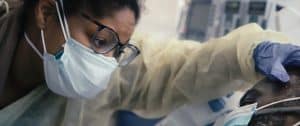
(Credit: National Geographic)
The answer to that question turned out to be Dr Nathalie Dougé, then an Internist at LIJ. A first-generation American of Haitian descent, her initial drafting into Heineman’s purview was an innocuous one. “Initially, I received an email through one of the executives from the hospital,” she tells me over a Zoom call. “It was presented that Matthew would be following a couple of nurses, a couple of doctors just to get our perspective of what’s going on day-to-day about the initial COVID-19 pandemic in our hospital. I thought it was gonna be like a day or two, to be honest with you.” Whilst she had no idea upon receiving the email that she was going to become the beating heart of Heineman’s film, the opportunity to “represent a female black physician who wasn’t really present [in this story’s coverage]” was too important to turn down.
First Wave follows many staff members at LIJ – some named, like nurse Kellie Winslow, and some not – but Dr Dougé ends up being the focal point around much of the movie operates. She interacts with patients, she is forced to spend her birthday isolated at home with her dog (although she does get a surprise Zoom call from her friends), and her despairing breakdowns capture the moments of emotional hopelessness those on the frontlines could feel as the days turned into weeks turned into months with seemingly no let up. Throughout, it’s admirable how much Dr Dougé is willing to entrust herself with Heineman’s camera and team. To let her guard down and let us see those moments of vulnerability and the crushing toll walking into that situation every day can take on a person.
“By nature, I tend to be a transparent open individual. I used to think I was pretty good at compartmentalising. As a profession, we are trained to deal with hard situations, trauma, death and kinda push through, because there’s another job at hand, there’s multiple patients we work through… But with the pandemic, especially at the height with the volume of patients, chaos, unknowns, fear, and volume of emotions… it became very, very hard to separate things.”
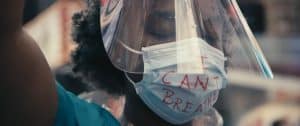
(credit: National Geographic Documentary Films / The First Wave)
And, then, of course, there was the murder of George Floyd on 25th May 2020. “When I found out about the murder of George Floyd just from an emotional standpoint, there was a time where I told Matt and the team, ‘look, I just need a break from everything. I don’t even know how to process everything that’s going on even in my own mind, let alone on camera.’” Heineman and his team, for their part, took to the streets, capturing the protests which sparked up in response and even some footage of the antagonistic and violent escalations the NYPD utilised in an effort to snuff out the lawful and peaceful demonstrations. “We shot between 1,000 and 1,500 hours of footage… a good chunk of that was shot in the streets during the protests.” But it was when Dr Dougé returned to filming that he would capture one of the most powerful sequences I’ve seen in a film in years.
“So that particular march was called Frontline Workers on the Frontlines. Most of the protests were peaceful but there were some moments with physical altercations with protestors. So, as a response, healthcare workers, particularly nurses and physicians, went out with our white coats and scrubs to act as a human barrier in an effort to defuse that tension.” As Dr Dougé marches, she finds herself drawn to a young Black man venting his fears and frustrations into the face of an uncaring police officer who is part of the barricade. “If you pay attention to the film, I’m actually just listening to this gentleman talk. He was just trying to voice who he was as a person and a Black man who’s not a threat just by being in someone’s presence. My perception was this man just wanted to be acknowledged for who he was without any additional stereotypes or biases. And when the officer made that decision to not acknowledge him, it looked he was just triggered.”
“My soul just could not take, in my watch, the loss of another life taken senselessly due to something that was completely avoidable. So, whatever I could to help intercede and help calm down the situation, that’s what I had to do.” Said interceding involved her standing between the officer and the man, and slowly moving him along with an almost desperately pleading, “your family cares about you.” “No matter how much people say that some are loners,” she reflects on our call, “a lot people have someone that cares about them and I wanted him to remember that he’s not alone. That he has a whole community behind him. That he has a lot of people who care about him and want to support him for just being him.”
It’s a message which clearly breaks through to him. Shortly after turning to walk away, he turns back around and, unprompted, gives Dr Dougé a hug. “When I think about that, I feel at that moment he saw me. I hadn’t received a hug in how long because of the pandemic and I just felt so tired cos you’re just always trying to give. So, that hug was something I needed.” It’s an act of selfless connective kindness, at a time when everybody was being more and more isolated in the face of life’s cruelty, being reciprocated with similar selfless connectivity. A testament to the best that humanity can provide each other in times of crisis. Dougé agrees. “That whole scene touches me because, when we are all truly open and vulnerable with each other and put our guards down, we are really able to see each other for who we are and what we actually need in the moment. That moment also touches me in ways I didn’t realise until I saw it back.”
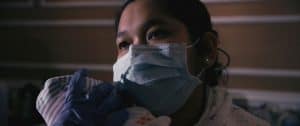
(Credit: National Geographic)
These moments of compassion ultimately end up being the light in the tunnel of The First Wave. Heineman refuses to look away from the distressing realities of trying to mitigate a pandemic so catastrophic they had to build mass graves in New York. One harrowing sequence follows a recently-deceased patient as they are boxed up, transferred down to the morgue, moved onto a different stretcher and then laid to temporary rest inside of a meat-packing truck alongside dozens upon dozens of other numbered-not-named bodies due to the morgue being completely out of space. But he also tempers those scenes with moments of grace and levity. Scenes of hospital staff coming to each other’s mental aid when things begin to overwhelm, the family of patient Brussels Jabon all taking care of each other and Brussels’ new-born child as best they can whilst COVID goes around the house, and the resiliency of Ahmed Ellis whose journey from critical condition to initial recovery is covered throughout Heineman’s filming period.
Not that this balance – of the grim chaos which threatened to take everyone down completely and the heartwarming hope of those who made it out alive, of giving viewers reasons to keep watching without trivialising the many who lost their lives – came about easy. “It was an ongoing struggle in the edit room,” Heineman makes sure to stress. “Every single frame, pixel, sound was heavily considered and thought through. Never at any point did I want it to feel exploitative.” In actuality, much of that balance ended up being nailed once he and his team settled on what the finished film’s narrative scope was going to be. “We continued to shoot through the Summer and the Fall, but every time I tried to cut in a scene from then it just didn’t work. So, when we came up with the title The First Wave, which gave us those goalposts from March to June, it really helped us editorially because it gave us a structure and an endpoint. And within that timeframe, all of our main storylines had very distinct arcs. So, it just worked.”
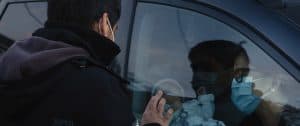
(credit: National Geographic Documentary Films / The First Wave)
Tellingly, a lesser movie might have ended on a scene similar to the one which concludes Ellis’ arc. A man introduced almost incapable of doing anything due to being so ravaged by the effects of COVID, finally sat at home with his family and neighbourhood welcoming him back whilst Nina Simone’s “Feeling Good” plays on top. Instead, Heineman’s film goes back to Dr Dougé, ruminating on the toll of the last four months – affectingly connecting the existential similarities of George Floyd’s murder and those of minorities she has to watch die from COVID cutting off their ability to breathe – before walking back into the fray to try it all again as she repeats “OK” to herself like a mantra. At once ominous, since we all know the worst of the pandemic did not dissipate with the re-opening of New York City, but also determined. Heineman at first resists the urge to try and distil a singular intended takeaway from his movie, but does eventuality settle on that point.
“If I can distil it down to one thing, I think it would be about how human beings come together in the face of crisis. Yes, it was a terrifying film to make but I think the overwhelming feeling we all had was inspiration. We were deeply inspired by the courage, tenacity, fortitude, love and humanity we witnessed every single day. That’s what drove me to make this movie, what drove me to keep going into the hospital every single day. There’s no question that we’ve all been changed forever. You’ve been changed, I’ve been changed, the fabric of society has been changed. So, I hope the film also provides a vehicle through which we can all reflect on what we’ve gone through. What have we learned? How can we apply what we’ve learned to the present and the future?”
Dr Dougé – who, in the aftermath of filming, had to step back from full-time practice because of the collective mental trauma under COVID – hopes that the film allows her other healthcare professionals the chance to properly process the mental effects of the pandemic. “Hopefully others in the healthcare system can finally see that we need have to have that moment where we step back and truly process all that’s been going on in order to keep doing this. Because out of sight out of mind does not really work.” For those outside of the frontlines, she hopes The First Wave “reinvigorates a sense of urgency” in trying to contain future COVID waves. In particular, she’s decidedly unamused by the hesitancy around vaccines and swift abandonment of proven safety measures like mandatory masks and social distancing.
“Healthcare workers and systems are not the only saving grace. Everyone plays a part in the progression of this pandemic and hopefully the end of it. I want everyone to take accountability for their actions. This is not about politics or loss of rights as a citizen. It’s about the preservation of a quality of life that everyone wants. When you break down the film, it’s about humanity. The complex face of emotions in response to a crisis. It shows that, when we are collectively together for a clear vision or action, we can get things accomplished in a pretty efficient manner.
“We play a part. Inaction is not ok. Complacency is not ok. I am someone who is advocating for the vaccine, but it’s not the be all end all. It’s not a cure. People can still get sick, just hopefully not die or need the hospital. Whatever we can do to end senseless suffering, I’m all for. So please get a vaccine, please wear a mask, get tested frequently if you need to. Cos we know that those measures work, that’s how we got out of the first wave.”
The First Wave, a National Geographic documentary film, is now playing in select cinemas.

